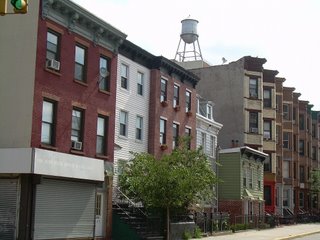REBNY's Spinola on development: "you don't want a 25-story building next to a single-family home" (but there's one planned for Atlantic Yards, pretty much)
There's an intriguing moment in an interview with Steven Spinola, the president of the Real Estate Board of New York, conducted by City&State's Nick Powell, regarding Mayor Bill de Blasio's plans to offer developers more density in exchange for "affordable housing."
"I think one of the things that we think needs to be recognized is you're not going to provide the housing that the city needs by saying we're going to build one- and two-family homes.... We need density. Now, it should be responsible density. It should be in areas that are close proximity to public transportation. It should be in areas where you have similar size buildings or buildings that, in effect, build up to it. The area is going to have to be identified for schools and open space."
He then said community boards should nominate places for increased density. "Now I do believe there are sites in all five boroughs that we can do that. But they have to be carefully chosen. And y'know, you don't want a 25-story building next to a single-family home."
(That sounds a little like Atlantic Yards, where a 27-story building east of Sixth Avenue, between Dean and Pacific streets, would replace the row of houses at right and be next to a row of four-story apartment buildings, not much larger than a single-family home. Here's a simulation by Jonathan Barkey.)
"But on the other hand, if you've already got six, eight, ten stories, is anyone going to know that the next one is twelve, or whatever?" Spinola continued. "So, it's complicated, the mayor wants a report by May 1. I think that's a very ambitious schedule. But I think... he will better outline what he thinks he needs to do."
"And our commitment to him is whatever we have to do that we can do to help him build those affordable units, both low- and middle-income, we're prepared to do," he stated.
Note that "middle-income" units, aka "workforce housing," are also affordable, but less burdensome to builders, since they require less subsidy and reap more rent. Of the rentals in Atlantic Yards that are supposed to be subsidized, 20% would be low-income, and 30% moderate- and middle-income.
From the article
The 3/12/14 article associated with the interview, SPINOLA ENCOURAGED BY DE BLASIO, noted:
"I think one of the things that we think needs to be recognized is you're not going to provide the housing that the city needs by saying we're going to build one- and two-family homes.... We need density. Now, it should be responsible density. It should be in areas that are close proximity to public transportation. It should be in areas where you have similar size buildings or buildings that, in effect, build up to it. The area is going to have to be identified for schools and open space."
He then said community boards should nominate places for increased density. "Now I do believe there are sites in all five boroughs that we can do that. But they have to be carefully chosen. And y'know, you don't want a 25-story building next to a single-family home."
 |
| The 27-story tower, B15, would occupy the plot that includes the first five buildings pictured. The two near left have already been demolished. |
"But on the other hand, if you've already got six, eight, ten stories, is anyone going to know that the next one is twelve, or whatever?" Spinola continued. "So, it's complicated, the mayor wants a report by May 1. I think that's a very ambitious schedule. But I think... he will better outline what he thinks he needs to do."
"And our commitment to him is whatever we have to do that we can do to help him build those affordable units, both low- and middle-income, we're prepared to do," he stated.
Note that "middle-income" units, aka "workforce housing," are also affordable, but less burdensome to builders, since they require less subsidy and reap more rent. Of the rentals in Atlantic Yards that are supposed to be subsidized, 20% would be low-income, and 30% moderate- and middle-income.
From the article
The 3/12/14 article associated with the interview, SPINOLA ENCOURAGED BY DE BLASIO, noted:
Steven Spinola, the president of the Real Estate Board of New York, plugged his organization's recent economic impact report and spoke at length about Mayor Bill de Blasio's goal to build and preserve 200,000 units of affordable housing in New York City.Unmentioned: the role of tax abatements in supporting the industry.
The economic impact study, based on 2012 data, shows that the city's real estate industry accounted for $106.2 billion in jobs, wages and output—including approximately 13 percent of the gross city product. Excluding property taxes, the real estate industry generated $1.6 billion in additional tax revenue for the city in 2012, including nearly $700 million from the construction industry and approximately $920 million from non-construction services. Real estate also supports 11 percent of the jobs in New York City.
Spinola said that he was encouraged by those numbers, which continue to increase each year, noting that the revenue generated by the industry helps pay for the vital services that make the city run.
...While the industry's boom over the last decade is in part attributed to the development-friendly policies of former mayor Michael Bloomberg, Spinola said he was encouraged by his and REBNY's initial discussions with de Blasio, specifically the mayor's willingness to work collaboratively on affordable housing despite his initial call for a "fundamental reset" with the development community.
Comments
Post a Comment